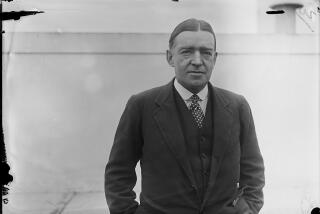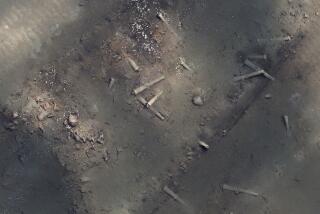Effort to tie North Carolina shipwreck to pirate Blackbeard advances
- Share via
Reporting from Beaufort, N.C. — In the fall of 1996, a private treasure-hunting company discovered a shipwreck in shallow waters a mile off the coast of this colonial fishing harbor.
Divers found a bronze bell dated 1705, an English musketoon gun barrel, and 18th century cannons and cannon balls.
North Carolina’s top marine archaeologists were pretty sure the wreck was the Queen Anne’s Revenge, the cannon-heavy flagship of the notorious pirate Blackbeard that ran aground here in 1718. But being scientists, they used buzzkill qualifiers such as “believed to be” and “consistent with” to describe the wreck.
Now, after examining thousands of artifacts and digging through historical records, those same archaeologists have finally delivered a verdict:
The ship is very likely, just about dead sure, all but certain, no doubt the Queen Anne’s Revenge. Pretty much.
“It’s in the right place, from the right time, with a preponderance of circumstantial evidence that has become overwhelming,” said David Moore, a sturdy, bearded nautical archaeologist who has spent 15 years diving the wreck.
No one has found “the smoking blunderbuss,” said Jeffrey Crow, a historian with North Carolina’s Office of Archives and History. But archaeological detective work has proved that every significant artifact — from swords to gold pieces to silver boot buckles to a diamond-encrusted wine glass — is dated before the 1718 wreck. That and other compelling evidence confirm that the ship can be none other than the Queen Anne’s Revenge.
The two marine archaeologists who wrote the scholarly paper that has prompted the state to seal the deal on Blackbeard’s 90-foot ship said, “It was the right-sized vessel, in the right place, at the right time, and with artifacts of the right period.”
Perfect! But then they had to add this downer: “And often, with archaeology, that’s as good as it gets.”
Mark Wilde-Ramsing, deputy state archaeologist and head of the Queen Anne’s Revenge project, wrote the paper with Charles Ewen of the anthropology faculty at East Carolina University. Although he has long believed the shipwreck is Blackbeard’s, Wilde-Ramsing urged caution for years as the wreck was studied.
“Extraordinary claims require extraordinary proof,” he said.
The shipwreck paper, to be published next spring in the scholarly journal Historical Archaeology, now provides that level of proof, he said.
The Queen Anne’s Revenge was originally a French slave ship named La Concorde. Blackbeard captured the vessel in the Caribbean in 1717, renamed it and armed it with fearsome cannons and swivel guns.
Blackbeard, variously known as Edouard or Edward Teach (or Tiche or Thatch), didn’t leave many clues. After his flagship ran aground on a sandbar in the spring of 1718 at what is now called Beaufort Inlet, he and his pirate crew took their sweet time unloading the ship, leaving behind virtually nothing personal or proprietary — no diary, no letter, no engraved ring.
(Blackbeard’s remains are certainly not available. In November 1718, his corpse was dumped at sea and his severed head mounted on a bowsprit after sailors dispatched by Virginia’s governor killed him in a showdown near Ocracoke).
As the paper’s authors note: “Short of a bell with La Concorde scratched out and Queen Anne’s Revenge crudely chiseled over it, what would constitute proof positive?”
How about these artifacts:
• A brass coin weight bearing the bust of Queen Anne of England, cast during her reign (1702-1714).
• A wine glass decorated with diamonds and tiny embossed crowns, made to commemorate the 1714 coronation of Queen Anne’s successor, King George I.
• A French hunting sword fragment featuring a bust that closely resembles King Louis XV, who claimed the French throne in 1715.
• A French-made urethral syringe for treating venereal diseases. A control mark showed that it was made in Paris between 1707 and 1715.
These and other discoveries helped rebut a 2005 International Journal of Nautical Archaeology article that accused the state of prematurely certifying the shipwreck as Blackbeard’s. The article suggested “a strong tendency towards Ruling Theory, whereby researchers seem to shape evidence to fit a preconceived identification.”
That unpleasantness is long forgotten as overflow crowds have jammed the Queen Anne’s Revenge exhibit that opened June 11 at the North Carolina Maritime Museum in Beaufort, and as media coverage has fanned public fascination with all things pirate. It didn’t hurt that Hollywood’s latest installment of “Pirates of the Caribbean,” featuring the Queen Anne’s Revenge, is a summer blockbuster.
Only half the site has been excavated, Moore said. Just last month, a 3,000-pound anchor was brought to the surface.
It’ll be a long while before all the wreck’s estimated 750,000 artifacts — and perhaps the absolute, definitive, clinching proof of Blackbeard’s flagship — are hauled up and carefully examined, Moore said.
How long?
Moore shrugged. “I’d say another 15 years.”
More to Read
Sign up for Essential California
The most important California stories and recommendations in your inbox every morning.
You may occasionally receive promotional content from the Los Angeles Times.














